Knowledge of grips in table tennis is the first and foremost learning of every beginner.
If you don’t have a proper table tennis grip from the beginning, then you are supposed to fail in the long run. My technique of holding the table tennis racket was not correct in the past days, which restricted my level of play.
Holding the bat properly may be inconvenient to you in the early stages, but it will help you in the long run.
What is a Table Tennis Grip?
“Table tennis grip” is the holding technique of a table tennis bat in the proper way. Your grip should be the same during the play. However many greats make slight adjustments when they switch over from the forehand stroke to the backhand stroke and vice versa.
What is the Importance of Table Tennis Grips?
The most fundamental skill of your table tennis game is to be a master to control your strokes. A proper grip gives you the idea of the angle of your racket, and how to guide your strokes at the desired location. Without the proper grip, you can’t feel the racket angle. So how can you deal with the spins in table tennis?
Types of Table Tennis Grips
There are broadly two types of grips for holding a Table Tennis bat. The Shakehand grip is the most popular one. This grip looks like you are shaking your hand. And the Penhold grip looks like you are holding a pen.
Now let’s come to the details of the table tennis grips.
1. Shakehand Table Tennis Grip
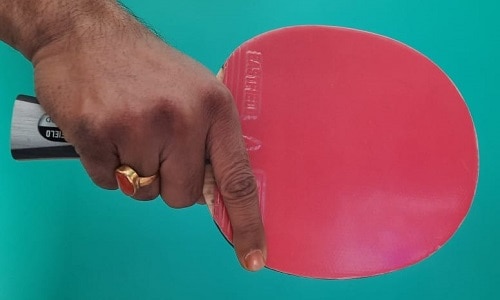
In this grip, try to hold the bat in a way that you are shaking your hand. Hold the handle with three fingers i.e. middle finger, ring finger, and pinkie. Then free your index finger and thumb. Place the index finger on the edge of the rubber on the backhand side and thumb on the blade or rubber on the opposite side in such a way that forms a V shape.
Earlier this grip was popular in European countries, but now this is also popular in Asian countries.
As a beginner, this is the most convenient way to hold a Table Tennis paddle.
Pros
- Easy for a newbie.
- You can use both sides, the forehand side, and the backhand side
- For attacking players, it helps to generate power both in the forehand and backhand.
- A wider selection of bats.
- Gives more support from the coach.
Cons
- The point of indecision or Crossover Point is when you have to decide whether you use either the forehand side or the backhand side.
The Shakehand grip is of two types. One is the Shallow Shakehand grip, and the other is the Deep Shakehand grip.
1. Shallow Shakehand Grip
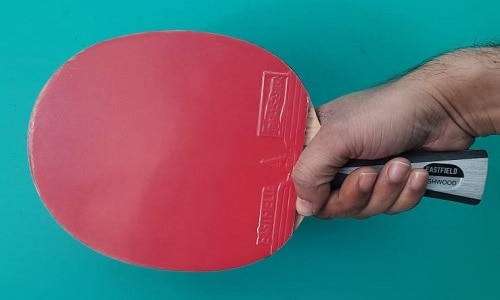
Relax your index finger on the edge of the rubber on the backhand side and then relax your thumb on the underneath of the blade on the opposite side in such a way that forms a V shape.
Pros
- It is a natural way to hold a racket and is easy for beginners.
- More power both in the forehand and backhand stroke.
- More wrist flexibility.
Cons
- Weak ” Crossover Point” i.e. stage of indecision when you have to decide whether you use either a forehand shot or a backhand shot.
2. Deep Shakehand Grip
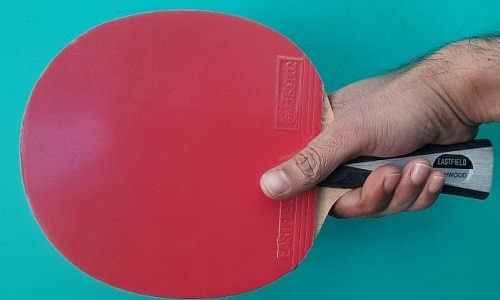
The Deep Shakehand grip is the same as the shallow Shakehand grip except in the deep Shakehand grip the thumb relaxes on the rubber of the bat.
Pros
- It is easier to control the backhand stroke than the shallow shakehand grip.
- It is a firm grip which adds more control in strokes.
Cons
- Less flexibility of the wrist gives less power and spin than the shallow shakehand grip.
- Weak ” Crossover Point” same, as in the shallow shakehand grip.
2. Penhold Table Tennis Grip
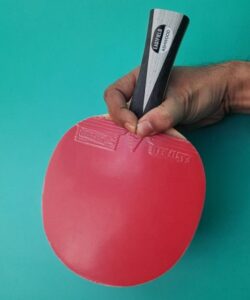
In this form of grip, the index finger and thumb are curled around the edge of the paddle to form a ‘C’ shape and relax on one side of the rubber. The other three fingers act as support on the other side of the rubber. It is much like you are holding a pen.
This grip is mainly popular in China, Korea, and Japan, the three Asian giants in the game of table tennis.
Pros
- You can use your wrist much more easily than the shakehand grip.
- Free movement of the wrist makes the forehand stroke stronger than the shakehand grip.
- The Flexible wrist makes it easy to serve with more variations.
- Quick blocking or pushing with more control.
- No “Crossover Point” as the same side is used both for the forehand and backhand side.
- Difficult to predict.
Cons
- You can’t use both sides of the racket for stroke-making.
- Weak for backhand as a generation of power is less. compared to Shakehand Grip.
- Difficult to generate backhand topspin.
- Difficult to master.
- Support from the coach is less.
Players who use the Penhold type grip, tend to stay close to the table for blocking and pushing on their backhand side. And when they attack with the forehand side, they generate massive power with either drive, topspin, or looping shots.
The Penhold Grip is of three types.
1. Chinese Penhold Grip

In this type of grip, hold the blade downward, with your index finger and thumb wrapped around the edge to form a ‘C’ shape. Then curl the other three fingers of the hand gently along the rubber on the opposite side.
Players who stick closer to the table prefer this grip.
Pros
- Free movement of the wrist.
- A flexible wrist will allow putting massive spin in attacking strokes and serves.
- Excellent forehand strokes with easier blocking and pushing on the backhand side.
Cons
- It is difficult to generate backhand topspin.
2. Japanese Penhold Grip
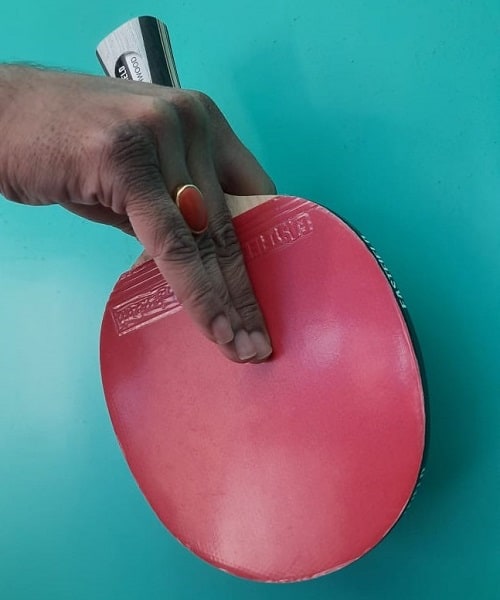
The difference is that in the Japanese grip, the fingers on the back of the racket are straightened rather than curled in the Chinese grip.
Pros
- Straightening of the fingers behind the bat adds more power for forehand strokes.
- Easy to play far from the table.
Cons
- This variation slows down the blade movement.
- So you have to put a lot of effort into adjusting your blade angle at the time of making a shot.
- This technique is difficult to master.
3. Reverse Penhold Backhand Grip:
This new version is like the Chinese Penhold Grip except for the back of the Penhold i.e. where the three fingers rest, is used to hit backhand shots.
Pros
- It eliminates the weakness of the Chinese Penhold grip for backhand shots.
- You can generate a powerful heavy backhand topspin stroke away from the table.
Cons
- You will face the same problem of “Crossover Point” as in the Shakehand grip.
Some players use a combination of the Chinese Penhold Grip with the Reverse Penhold Backhand grip for better performance.
3. Other Types of Grips
Other than these 2 types of table tennis grips, there are some uncommon methods of holding a table tennis bat.
1. Seemiller Grip
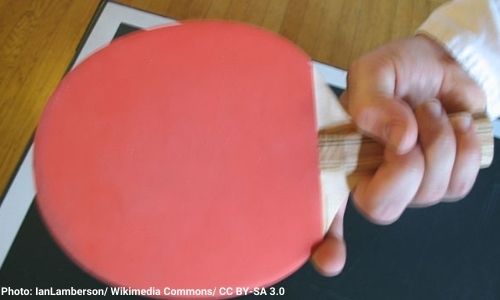
This grip came with the name of Dan Seemiller, who first introduced this grip in the world in 1970.
It is a bit like the Shakehand grip where the index finger and thumb are used to grip either side of the racket, while the three other fingers hold the handle. As the same side is used for both the forehand and backhand strokes, there is no crossover point in this grip.
This grip is famous for generating forehand strokes with more power and topspin.
But, this is a fixed grip and there is no wrist movement in this grip. You can’t use your backhand side to make a backhand topspin stroke.
2. Pistol Grip
This is a non-standard grip that gives you the feeling that you are holding a pistol. Actually, the racket is designed in a nonconventional way for this type of grip. You can not play any match with this grip as it does not confer the rules of ITTF.
Conclusion
Now, it’s time for experimentation. You have known the Shakehand and Penhold grip. Play using both grips. See which feels more comfortable to you and stick with that grip.
